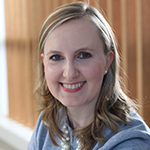 Ana Kalugina, a graduate student in the Master of Business Administration/Master of Professional Studies in Real Estate program at Cornell University, is expected to receive her Master of Business Administration/Master of Professional Studies in Real Estate program at Cornell University in spring 2017. She is co-founder of the university’s Real Estate Career Work Group and vice president of career events for its Associate Real Estate Council. She also works as a research intern for Hodes Weill & Associates, a real estate advisory boutique with a focus on the investment and funds management industry.
Ana Kalugina, a graduate student in the Master of Business Administration/Master of Professional Studies in Real Estate program at Cornell University, is expected to receive her Master of Business Administration/Master of Professional Studies in Real Estate program at Cornell University in spring 2017. She is co-founder of the university’s Real Estate Career Work Group and vice president of career events for its Associate Real Estate Council. She also works as a research intern for Hodes Weill & Associates, a real estate advisory boutique with a focus on the investment and funds management industry.
NAIOP: How did you first become interested in a career in commercial real estate?
Kalugina: I have always been fascinated by real estate and its connection to people. The majority of human lives revolves around real estate, and most of us don’t even realize it. Whether living, working, or shopping, we all constantly deal with real estate. Even while enjoying the outdoors, a seemingly building-free environment, we’re still using real estate – land is real estate! I’m drawn to real estate because of its all-encompassing nature.
NAIOP: In what ways do you think you can make a difference in CRE?
Kalugina: My particular interest in real estate is twofold, but both emphasize the importance of it for people and the environment.
I am passionate about affordable housing. Housing is extremely important for building wealth — especially for people in the lower income bracket, as it constitutes a much bigger portion of their overall wealth. Housing markets throughout the country increasingly exhibit challenges of affordability, and governments at all levels are placing renewed emphasis on this issue. Mixed-income housing is especially popular, integrating affordable housing incentives into multifamily development projects. When housing is affordable, families and communities thrive: children perform better in school, individuals tend to be healthier and the economic base of the community is stronger. At the same time, affordable housing is by far the only real estate sector with strong demand fundamentals that will play a role in years to come as demand is certain to outpace supply.
I am amazed by the impact of real estate on the surrounding environment. Real estate industry can be a driver of change as the world combats global warming. More and more data is coming out showing that green buildings and overall resident- and tenant-friendly environments have not only a positive correlation with returns, but also with the health and well-being of occupants, providing opportunities to reduce costs and create value. Through real estate, I feel determined to make a positive contribution to the natural environment. Immersing myself in the Sustainable Global Enterprise Immersion last semester, I find the concept of sustainability and serving the greater good fulfilling.
NAIOP: How do you anticipate that NAIOP will help you advance your career in CRE?
Kalugina: NAIOP has provided me with an access to a group of individuals who are passionate about real estate – people with whom I have been able to network with following the Commercial Real Estate Conference this fall.
NAIOP: Which CRE trends or technology are you most excited about, or do you see having the biggest impact on the industry in the next 5-10 years?
Kalugina: Jane Jacobs, author of Death and Life of Great American Cities, would be excited at the reemergence of cities as lively environments attracting both young and old and – more importantly — the fact that the cities aren’t dying. The flight to the suburbs was for the most a flight of people in search of more comfortable, and livelier living environments. And as in the last decades, both public and private enterprises recognized the importance of urban environments being safe and walkable, and having a good public transportation system and mixture of uses, the real estate profession plays an ever more important role. As such, I want to create safe living environments for people, positioning everyone to succeed in life no matter what his or her demographic characteristic and income level are. And at the same time to create sustainable communities that limit adverse impact on the surrounding environment at large. The high demand for affordable housing combined with sustainable building techniques can make a profound impact on both the people and the environment involved.
NAIOP: Who are your personal or professional inspirations?
Kalugina: Before I started grad school, I read Better Places, Better Lives: Biography of James Rouse, a book about James Rouse and the impact he had on the real estate industry. Emphasizing the need for residential development, he was influential in creating environments with a strong sense of community. One that creates an atmosphere and pace of the small town and village. A community which can meet as many needs as possible of the people who live there, and one that can incorporate a natural contact with one another. In other words, a community that can create a spirit and feeling of neighborliness and a rich sense of belonging – belonging that Jane Jacobs has referred to in her book.
While in school I have also become familiar with Jonathan Rose, a contemporary real estate developer, whose achievements in sustainable real estate are bar none. As someone who is very interested in the triple bottom line, and believes that real estate is the industry with substantial impact on people and the environment, I am fascinated by both J. Rouse and J. Rose and by how much both of them were ahead of the people of their time!
This is part of a series of profiles of NAIOP’s 2016 Diversity CRE Scholarship recipients. The award benefits students pursuing careers in commercial real estate. Five $5,000 scholarships were awarded to individuals from demographics that are traditionally under-represented in commercial real estate and who are part of the NAIOP University Membership program. Learn more about NAIOP’s strategic initiatives to advance diversity in commercial real estate at the diversity resource center.














